What is New Hampshire’s Blue Economy?
New Hampshire’s coastline measures in at just under 18 miles – the smallest coastline of any state that borders an ocean – but forms the foundation of a dynamic regional economy. What was historically a hub of commercial fishing, shipyards and tourism has, over time, diversified considerably into exciting sectors like renewable energy, manufacturing, navigation and autonomous vehicles. These sectors of the economy that use and affect water-related resources are what’s become known as the blue economy.
New Hampshire’s blue economy is made up of companies ranging from startups to subsidiaries of international businesses, researchers and students at the University of New Hampshire and other educational institutions, federal agencies, the U.S. Navy and other parts of the Department of Defense. While the term “blue economy” may not be part of the common vernacular, many people understand the impact and importance of commercial and recreational fishing, marine tourism, the Portsmouth Naval Shipyard and other highly visible employers and sectors.
Wild Caught Seafood
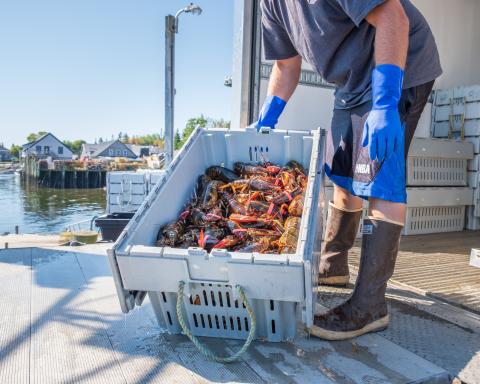
In addition to what’s known as ground fishing, which are fish such as cod, haddock and hake that live on or near the seafloor, there are boats that harvest lobster, deep-sea fish like tuna, scallops and native and invasive crab species including Jonah and green crab. Lobster has become the most important species in the wild-caught fishery.
Aquaculture

Aquaculture, which includes farming oysters and finfish, is an increasingly important sector. Oysters are primarily cultivated in Great and Little Bay, which form New Hampshire’s tidal estuary connecting rivers from New Hampshire and Southern Maine to the Atlantic Ocean. Open-ocean 3-D aquaculture, also called integrated multitrophic aquaculture, has promise for farming seaweed, oysters, mussels, scallops and steelhead trout, but is limited to applied research so far. Such research focuses on increasing environmental sustainability, fostering and expanding new wild and farmed species markets, increasing consumer interest and access to local seafood and improving the economics for commercial fishers and aquaculturists.
Tourism
Tourism continues to utilize New Hampshire’s beautiful coastline and waters. This starts with the state’s public beaches, such as the boardwalk at Hampton Beach, and Odiorne Point State Park, home to the popular Seacoast Science Center. Then there are the many reasons residents and visitors enjoy getting out on the water— whether to watch migrating whales, enjoy a sunset cruise, go deep sea fishing or visit the historic Isle of Shoals.
Ports and Shipyards
The Portsmouth Naval Shipyard employs over 7,000 civilians – including nearly 3,000 from New Hampshire – and handles the U.S. Navy’s nuclear-powered attack submarine fleet. The shipyard, located just over the state border in Kittery, Maine, is the Navy’s oldest continually operating shipyard and continues to see construction of new dry docks and other facilities.
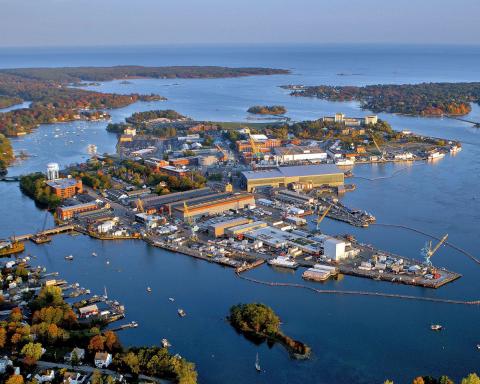
Portsmouth has a deep-water port, which imports and exports products and components for wide-ranging uses within the blue economy. Overall, the port handles about 3.5 million tons of cargo per year. While New Hampshire doesn’t have offshore wind turbines, the harbor is set to be a staging and transport location for offshore wind components including towers, blades and hubs. Federal funding from the Army Corps of Engineers, supplemented by funds distributed through the 2021 Infrastructure Investment and Jobs Act, are financing a project to widen the turning basin in the Piscataqua River, which will allow the harbor to accommodate large ships with heavier loads. Port facilities are in Portsmouth, Hampton, Rye and the Isle of Shoals.
UNH and the Private Sector

Researchers at UNH and other institutions such as the Great Bay National Estuarine Research Preserve complement the development and growth of a burgeoning private blue economy sector. UNH researchers are exploring new frontiers in a wide variety of fields, some commercial and some more exploratory. Examples include environmental DNA analysis, environmental restoration, coastal resiliency, hydrogeology and more. UNH research is conducted on campus, at the Jackson Estuarine Laboratory, at the Judd Gregg Marine Research Complex, in the Gulf of Maine and around the world.
Private sector businesses, particularly earlier stage and startup companies, engage UNH around conducting research, co-location, and workforce development. Companies will rent space and equipment, and hire interns, from campus partners including The John Olson Advanced Manufacturing Center, the Interoperability Laboratory, and the Chase Ocean Engineering Lab.
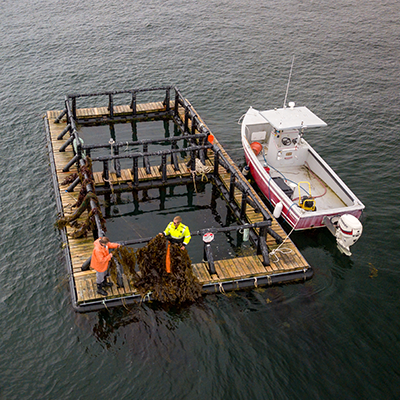
New Hampshire Sea Grant’s AquaFort serves as an offshore aquaculture training platform and research site. The Center for Business Analytics is working with an ocean monitoring businesses to help monetize their data. Startups in the blue economy space use UNH programs through UNHInnovation to tap into these resources and more, such as the FOSTER initiative for grant funding and I-Corps for entrepreneurial training.
Renewable Energy
Researchers at the Center for Ocean Renewable Energy are testing systems for wave, tidal and offshore wind energy. Wave energy is generated in the open ocean, while tidal energy is generated close to shore where tides ebb and flow. Wave energy testing has involved UNH faculty and students working with the private industry to test systems and conduct viability studies. Upcoming research projects will test a fully operational system off the Isle of Shoals, weighing 48 tons and spanning 70 feet top to bottom, and another will focus on pumping nutrient rich water to the surface for kelp farming.
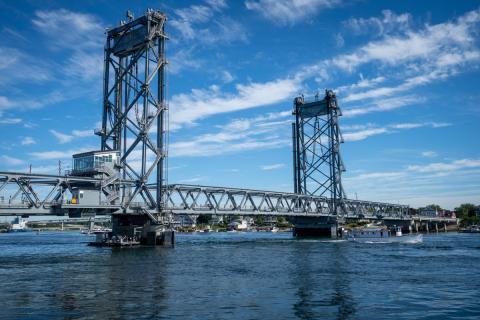
According to the U.S. Energy Information Administration, the Gulf of Maine (which includes New Hampshire’s coastline) is one of two places in the country that have potential for commercial tidal power. The tidal energy test site run by UNH at the General Sullivan Bridge, where the Lower Piscataqua enters Little Bay, is considered a full-scale test site for both vertical and horizontal axis turbines.
UNH research has investigated strategies for reducing the cost of wind energy, maximizing power output, bringing floating wind turbine technology to maturity and much more. Regardless of whether offshore wind turbines are constructed in New Hampshire waters, UNH and private industry partners are poised to play an ongoing role in testing by providing and supporting technology and infrastructure for offshore wind in New England. A number of New Hampshire based businesses are well positioned to supply products and services including construction, electricity transmission and cabling, environmental monitoring and logistics.
Marine Sonar and Acoustics
One example of private sector commercial activity is marine sonar and acoustics. These technologies are sold from New Hampshire around the world for use in defense, ports, ocean surveying, energy production (including offshore renewables and oil/gas), university research, and more.
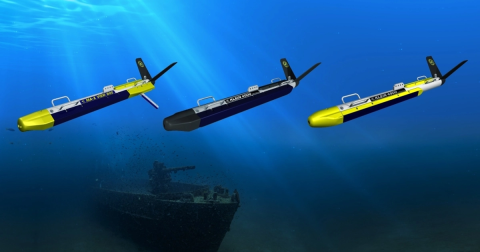
There are different niches New Hampshire companies fill, from early research and prototyping to manufacturing at scale. One company, Nashua founded Scientific Solutions Inc., provides marine acoustics technology to government clients, including to help protect marine mammals from ship strikes and other injuries from interactions with commercial activity. Another company, Klein, manufactures high resolution sonar systems that have been used to locate and study ship and plane wrecks, site windfarm locations, recover drowning victims, and even identify and map underwater navigation obstacles in the local Merrimack River.
Marine Autonomous Vehicles
Marine autonomous vehicles are essentially drones in the water. Teledyne Marine manufactures these solutions in New Hampshire through two subsidiary companies. One application of marine autonomous unmanned vehicle technology is for offshore wind, a growing source of energy and jobs for coastal New England.
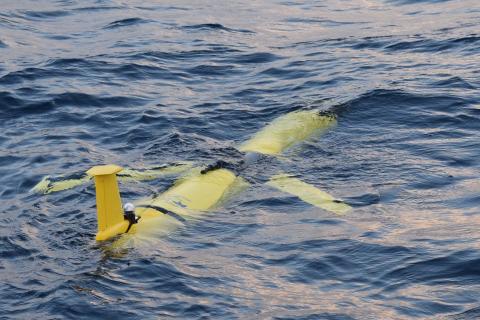
Offshore wind requires year-round ecosystem monitoring and security, only possible with marine autonomous vehicles. This technology is also used to take measurements of temperature, ocean dynamics, fish and marine mammal populations and other data points throughout the world, which is critical to understanding the impacts of climate change on our oceans. Autonomous vehicles have brought down the cost of ocean mapping considerably, which is critical for maritime navigation, telecommunications, offshore energy and more. This technology is also used to monitor activities in marine protected areas, detect illegal fishing, conduct reconnaissance and even alert law enforcement to piracy, human trafficking and more.
Other Industries
Many if not most companies innovating in New Hampshire’s blue economy space work closely with the US Department of Defense. Given the security classification of these contracted products and services, there can be limited publicly available information, making it more challenging to capture and communicate the full depth and breadth of New Hampshire’s blue economy. The New Hampshire Aerospace & Defense Export Consortium brings together companies supplying or manufacturing products for the navy-marine industry. Yet there are businesses that are more public facing, some of which are briefly described in this article.
Critical Communications, Controls, and Instruments (C3I), based in Exeter, specializes in marine communications, controls and instruments. The firm provides software solutions, equipment, and design services for the U.S. Navy, U.S. Coast Guard, and commercial clients including shipbuilders. One of C3I's core offerings is lighting control systems for vessels with aircraft stationed aboard, which includes supporting missions requiring night vision.
Cirtonics, based in Milford, delivers complex electronic and electro-mechanical systems in support of industries tied to the blue economy. Cirtronics offers contract advanced manufacturing services for applications including marine renewable energy, marine autonomous vehicle systems and surface robotics.
Hydrocomp, based in Newmarket, provides tools for naval architects and engineers aid in the design and analysis of a wide variety of boats, ships, submersibles, and other vehicles around the world, particularly with boat propellers.
Jewell Instruments, based in Manchester, specializes in designing and manufacturing high precision products including acceleration and tilt sensors, electronic compasses, avionics components, solenoids, and panel meters for marine industries, among others.
Madco3D is a startup in Rochester that manufactures 3-D printed cement coral for reef restoration, and has plans to manufacture 3-D printed seawalls to combat sea level rise and underwater art installations for ecotourism.

Northeastern Regional Association of Coastal Ocean Observing Systems (NERACOOS), a Portsmouth based nonprofit organization, operates a network of buoys, high-frequency radars, monitoring stations, models, and other ocean observing assets that collect data on regional marine conditions and make that data publicly available.

Another local company, Subcom based in Newington, engineers, manufactures, and installs subsea fiber optic data cables to facilitate global communication, including connecting Myrtle Beach to Brazil, Singapore to France, India to the Middle East and Europe, Iceland to Ireland, New York to Spain and England, and much more.
New Hampshire’s blue economy is ever evolving, with new investments, research and businesses creating jobs and helping solve the challenges of both today and tomorrow in our local and global waters. Traditional sectors are in many cases adapting and thriving, and newer sectors are gaining footholds in the state as the blue economy continues to grow and diversify. UNH is a national leader in marine research and innovation, and despite New Hampshire’s limited coastline, there are companies adding value up and down the supply chain to customers here in New England and around the world.
UNH Extension’s Community & Economic Development (CED) team serves as a convenor at the intersection of communities, industry and UNH resources. Through partnerships and data-driven analysis, the CED team is working to expand the capacity and cohesion of New Hampshire’s blue economy.
Any reference to commercial products, trade names, or brand names is for information only, and no endorsement or approval is intended.
Community & Economic Development Update Newsletter
The Community and Economic Development Update is a monthly newsletter that includes stories about local community and economic development programs, information about upcoming workshops and events, and resources for new community and economic development topics.

